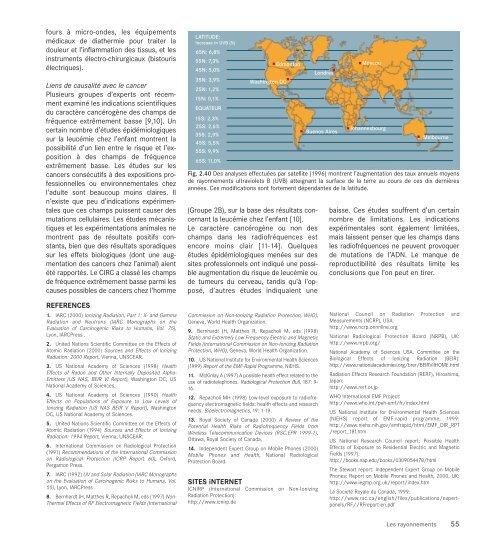Le cancer, un fardeau mondial - IARC
Le cancer, un fardeau mondial - IARC
Le cancer, un fardeau mondial - IARC
You also want an ePaper? Increase the reach of your titles
YUMPU automatically turns print PDFs into web optimized ePapers that Google loves.
fours à micro-ondes, les équipements<br />
médicaux de diathermie pour traiter la<br />
douleur et l’inflammation des tissus, et les<br />
instruments électro-chirurgicaux (bistouris<br />
électriques).<br />
Liens de causalité avec le <strong>cancer</strong><br />
Plusieurs groupes d’experts ont récemment<br />
examiné les indications scientifiques<br />
du caractère cancérogène des champs de<br />
fréquence extrêmement basse [9,10]. Un<br />
certain nombre d’études épidémiologiques<br />
sur la leucémie chez l’enfant montrent la<br />
possibilité d’<strong>un</strong> lien entre le risque et l’exposition<br />
à des champs de fréquence<br />
extrêmement basse. <strong>Le</strong>s études sur les<br />
<strong>cancer</strong>s consécutifs à des expositions professionnelles<br />
ou environnementales chez<br />
l’adulte sont beaucoup moins claires. Il<br />
n’existe que peu d’indications expérimentales<br />
que ces champs puissent causer des<br />
mutations cellulaires. <strong>Le</strong>s études mécanistiques<br />
et les expérimentations animales ne<br />
montrent pas de résultats positifs constants,<br />
bien que des résultats sporadiques<br />
sur les effets biologiques (dont <strong>un</strong>e augmentation<br />
des <strong>cancer</strong>s chez l’animal) aient<br />
été rapportés. <strong>Le</strong> CIRC a classé les champs<br />
de fréquence extrêmement basse parmi les<br />
causes possibles de <strong>cancer</strong>s chez l’homme<br />
LATITUDE:<br />
Increase in UVB (%)<br />
65N: 6,8%<br />
55N: 7,3%<br />
45N: 5,0%<br />
35N: 3,9%<br />
25N: 1,2%<br />
15N: 0,1%<br />
EQUATEUR<br />
15S: 2,3%<br />
25S: 2,6%<br />
35S: 2,9%<br />
45S: 5,5%<br />
55S: 9,9%<br />
65S: 11,0%<br />
Washington DC<br />
Edmonton<br />
Fig. 2.40 Des analyses effectuées par satellite (1996) montrent l’augmentation des taux annuels moyens<br />
de rayonnements ultraviolets B (UVB) atteignant la surface de la terre au cours de ces dix dernières<br />
années. Ces modifications sont fortement dépendantes de la latitude.<br />
(Groupe 2B), sur la base des résultats concernant<br />
la leucémie chez l’enfant [10].<br />
<strong>Le</strong> caractère cancérogène ou non des<br />
champs dans les radiofréquences est<br />
encore moins clair [11-14]. Quelques<br />
études épidémiologiques menées sur des<br />
sites professionnels ont indiqué <strong>un</strong>e possible<br />
augmentation du risque de leucémie ou<br />
de tumeurs du cerveau, tandis qu’à l’opposé,<br />
d’autres études indiquaient <strong>un</strong>e<br />
Londres<br />
Buenos Aires<br />
Moscou<br />
Johannesbourg<br />
Melbourne<br />
baisse. Ces études souffrent d’<strong>un</strong> certain<br />
nombre de limitations. <strong>Le</strong>s indications<br />
expérimentales sont également limitées,<br />
mais laissent penser que les champs dans<br />
les radiofréquences ne peuvent provoquer<br />
de mutations de l’ADN. <strong>Le</strong> manque de<br />
reproductibilité des résultats limite les<br />
conclusions que l’on peut en tirer.<br />
REFERENCES<br />
1. <strong>IARC</strong> (2000) Ionizing Radiation, Part 1: X- and Gamma<br />
Radiation and Neutrons (<strong>IARC</strong> Monographs on the<br />
Evaluation of Carcinogenic Risks to Humans, Vol. 75),<br />
Lyon, <strong>IARC</strong>Press .<br />
2. United Nations Scientific Committee on the Effects of<br />
Atomic Radiation (2000) Sources and Effects of Ionizing<br />
Radiation: 2000 Report, Vienna, UNSCEAR.<br />
3. US National Academy of Sciences (1998) Health<br />
Effects of Radon and Other Internally Deposited Alpha-<br />
Emitters (US NAS, BEIR VI Report), Washington DC, US<br />
National Academy of Sciences.<br />
4. US National Academy of Sciences (1990) Health<br />
Effects on Populations of Exposure to Low <strong>Le</strong>vels of<br />
Ionizing Radiation (US NAS BEIR V Report), Washington<br />
DC, US National Academy of Sciences.<br />
5. United Nations Scientific Committee on the Effects of<br />
Atomic Radiation (1994) Sources and Effects of Ionizing<br />
Radiation: 1994 Report, Vienna, UNSCEAR.<br />
6. International Commission on Radiological Protection<br />
(1991) Recommendations of the International Commission<br />
on Radiological Protection (ICRP Report 60), Oxford,<br />
Pergamon Press.<br />
7. <strong>IARC</strong> (1992) UV and Solar Radiation (<strong>IARC</strong> Monographs<br />
on the Evaluation of Carcinogenic Risks to Humans, Vol.<br />
55), Lyon, <strong>IARC</strong>Press .<br />
8. Bernhardt JH, Matthes R, Repacholi M, eds (1997) Non-<br />
Thermal Effects of RF Electromagnetic Fields (International<br />
Commission on Non-Ionizing Radiation Protection, WHO),<br />
Geneva, World Health Organization.<br />
9. Bernhardt JH, Matthes R, Repacholi M, eds (1998)<br />
Static and Extremely Low Frequency Electric and Magnetic<br />
Fields (International Commission on Non-Ionizing Radiation<br />
Protection, WHO), Geneva, World Health Organization.<br />
10. US National Institute for Environmental Health Sciences<br />
(1999) Report of the EMF-Rapid Programme, NIEHS.<br />
11. McKinlay A (1997) A possible health effect related to the<br />
use of radiotelephones. Radiological Protection Bull, 187: 9-<br />
16.<br />
12. Repacholi MH (1998) Low-level exposure to radiofrequency<br />
electromagnetic fields: health effects and research<br />
needs. Bioelectromagnetics, 19: 1-19.<br />
13. Royal Society of Canada (2000) A Review of the<br />
Potential Health Risks of Radiofrequency Fields from<br />
Wireless Telecomm<strong>un</strong>ication Devices (RSC.EPR 1999-1),<br />
Ottawa, Royal Society of Canada.<br />
14. Independent Expert Group on Mobile Phones (2000)<br />
Mobile Phones and Health, National Radiological<br />
Protection Board.<br />
SITES iNTERNET<br />
ICNIRP (International Commission on Non-Ionizing<br />
Radiation Protection):<br />
http://www.icnirp.de<br />
National Co<strong>un</strong>cil on Radiation Protection and<br />
Measurements (NCRP), USA:<br />
http://www.ncrp.onnnline.org<br />
National Radiological Protection Board (NRPB), UK:<br />
http://www.nrpb.org/<br />
National Academy of Sciences USA, Committee on the<br />
Biological Effects of Ionizing Radiation (BEIR):<br />
http://www.nationalacademies.org/brer/BEIRVIIHOME.html<br />
Radiation Effects Research Fo<strong>un</strong>dation (RERF), Hiroshima,<br />
Japan:<br />
http://www.rerf.or.jp<br />
WHO International EMF Project:<br />
http://www.who.int/peh-emf/fr/index.html<br />
US National Institute for Environmental Health Sciences<br />
(NIEHS) report of EMF-rapid programme, 1999:<br />
http://www.niehs.nih.gov/emfrapid/html/EMF_DIR_RPT<br />
/report_18f.htm<br />
US National Research Co<strong>un</strong>cil report: Possible Health<br />
Effects of Exposure to Residential Electric and Magnetic<br />
Fields (1997):<br />
http://books.nap.edu/books/0309054478/html<br />
The Stewart report: Independent Expert Group on Mobile<br />
Phones: Report on Mobile Phones and Health, 2000, UK:<br />
http://www.iegmp.org.uk/report/index.htm<br />
La Societé Royale du Canada, 1999:<br />
http://www.rsc.ca/english/files/publications/expertpanels/RF//RFreport-en.pdf<br />
<strong>Le</strong>s rayonnements 55
















